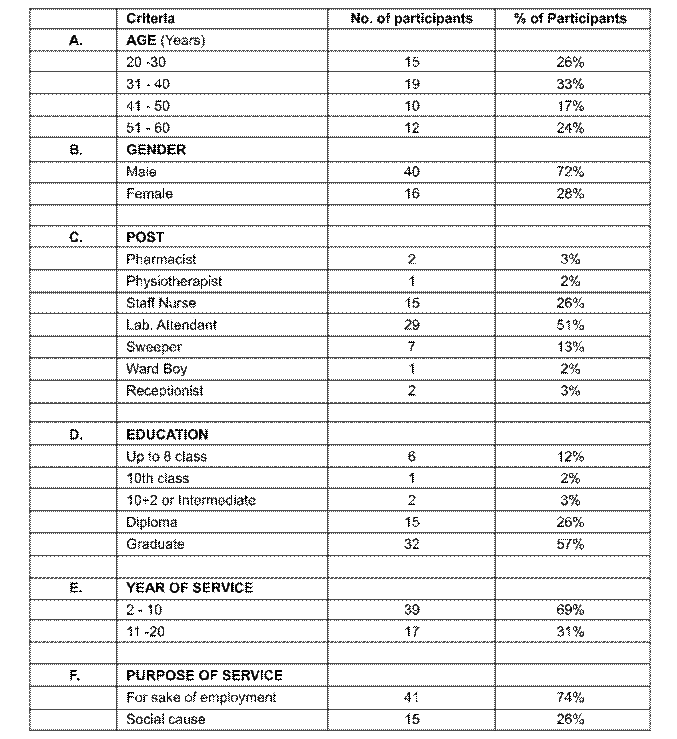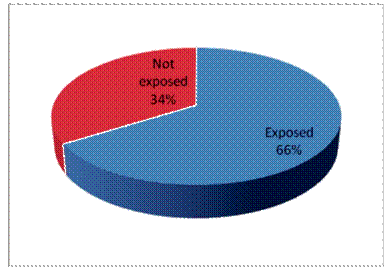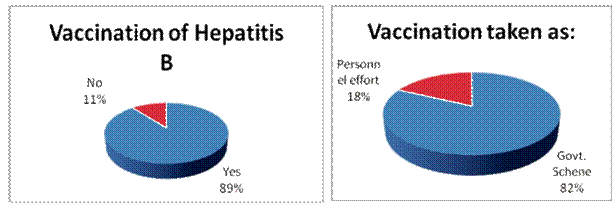STATUS OF HEPATITIS B VACCINATION AMONG PERSONS INVOLVED IN HEALTH CARE SYSTEM OF KANPUR DISTRICT HOSPITAL
Maneesh Kumar Singh*, Aditya Gupta*, Ajay Kumar Gupta**
**Associate Professor, University Institute of Pharmacy, C.S.J.M. University, Kanpur (U.P.) India
ABSTRACT
Person involved in health care system have a high risk of occupational exposure to many blood-borne diseases including Hepatitis B, and other viral infections. Hepatitis B is not only the most transmissible infection, but also the one of the preventable by vaccination. The present qualitative study was conducted to get a better understanding of participant's awareness regarding the challenges of working at health care system with particular reference with hepatitis B employed at the Ursala Horsmann Memorial District Hospital, & Cardiology Institute, Kanpur. A total of 56 screened person involved in the service of hospital were studied after getting their consent, all were explained about the objective of the study and were asked to fill a standard questionnaire regarding the same.
Keywords : Health Care System, Hepatitis B, HBV, questionnaire, qualitative study.
INTRODUCTION
Hepatitis B is one of the major diseases of mankind and is a serious global public health problem and is the tenth leading cause of death. In India, HBsAg prevalence among the general population ranges from 2 to 8%, which places India in an intermediate endemic zone for HBV (Singhal V et al., 2011). Hepatitis B is a blood-borne virus. Modes of infection include perinatal, and through percutaneous or mucosal exposure to infected blood or body fluids.
Occupational exposure of HBV is a well recognized risk for health care workers. Throughout the world, millions of healthcare professionals work in health institutions and it is estimated that 600,000 to 800,000 cut and puncture injuries occur among them per year, of which approximately 50% are not registered (EPINET, 1999). According to WHO, the proportion of health-care workers in the general population varied substantially by region (0.2%-2.5%), as did the average number of injuries per health-care worker (0.2-4.7 sharps injuries per year). The annual proportion of health-care workers exposed to blood-borne pathogens was 5.9% for HBV, corresponding to about 66,000 HBV infections in health-care workers worldwide (Prüss-Ustün et al., 2005).
Based on the prevalence of hepatitis B carrier state in the general population, countries are classified as having high (8% or more), intermediate (2-7%), or low (less than 2%) HBV endemicity; India is at the intermediate endemic level of hepatitis B, with hepatitis B surface antigen (HB5Ag) prevalence between 2% and 10% among the populations studied. The number of HBsAg carriers in India has been estimated to be over 40 million (4 crore). In India, of the 25 million infants born every year, over one million run the lifetime risk of developing chronic HBV infection. Estimates indicate that annually over 100,000 Indians die due to illnesses related to HBV infection (Martha Bhaskar Rao, 2012). This disease has no rationale treatment in Western medicine. Usually supportive measures are practised.
Now a days changing life style dietary habits and environment increasing morbidity and mortality rate due to liver disease. Changing life style mainly include stressful life, increased consumption of alcohol and drug addiction which are mainly responsible for increase incidents of accidents, Haemorrhage, Wound Trauma, Wounds, etc which increases chances of hepatitis as it is used to hepatitis like diseases. Furthermore, despite the availability of Hepatitis B vaccination since 1981, a large number of person involved in the service of hospital are still unvaccinated. The condition is almost same in most of the countries. From India there is very few data available on vaccination status of HCWs. Therefore it is important to know the attitude and awareness of person involved in the service of hospital about Hepatitis B infection and vaccination.
screened to study the status of Hepatitis B through the qualitative research (questionnaire based) at district hospital of Kanpur city.
The hepatitis B vaccine (Matthew Edey et al. 2010)
In the 1970s, Krugman observed that HBsAg was immunogenic, and that anti-HBs antibodies were protective against hepatitis B. A first-generation vaccine was subsequently developed, consisting of HBsAg extracted by plasmapheresis from HBV carriers, and then inactivated. This vaccine, manufactured by Merck, was approved by the Food and Drug Administration in 1981, and became widely available from July 1982. Asimilar vaccine was licensed at about the same time, produced by Institut Pasteur in France.
Modern ‘second-generation’ HBV vaccines are recombinant non-infectious subunit vaccines containing HBsAg. These are produced by the yeast Saccharomyces cerevisiae using recombinant DNA technology. There are two such HBV vaccine formulations available, Engerix B and Recombivax HB.
A third-generation vaccine has been produced from a mammalian cell line, although it is not yet in widespread use. It contains the pre-Si and pre-S2 antigens that are present on the viral envelope. These antigens are more immunogenic than the HBsAg present in second-generation vaccines.
Whichever vaccine is used, providing manufacturer’s recommendations are adhered to, immunogenicity and efficacy are considered equivalent. A large prospective trial has shown the vaccine to be safe and well-tolerated. There was a suggestion that women responded better than men to vaccination. When the vaccine is used in immunocompetent individuals using a three-dose schedule, a 90—95% seroprotection rate is expected.
METHODOLOGY
Present study aims to get a better understanding of participant’s (person involved in the service of hospital) awareness regarding the challenges of working at health care system with particular reference with hepatitis B; through firsthand experience, truthful reporting, and quotations of actual conversations. Study also aims to understand how the participants derive meaning from their surroundings, and how their meaning influences their behaviourwhich may ultimate affect the health of their own, family and hospital. Such direct observation reduces distortion between the observer and what is observed that can be produced by an instrument (questionnaire). It occurs in a natural setting, not a laboratory or controlled experiment.
In the present study, 56 screened participants, involved in health care services (other than doctors) from Ursala Horsmann Memorial District hospital, and Cardiology Institute, Kanpur. Status of hepatitis was mainly studied via direct interaction and filling questionnaire. Study was based on randomized selection of patients in mentioned study centres of random age groups and sex, so as to get firsthand experience, truthful reporting against the quotations of actual conversations as significant observations to draw results (Gupta AK et al., 2012).
RESULTS and DISCUSSION
As per methodology, equal opportunity was given to all district hospital employees irrespective to their age group, gender, job or post. Among the screened participants major contribution was offered by 31-40 years employee i.e. 33% followed by 20-30% (Table 1) and it was essential too as they may improve their and others health status by being aware of hepatitis like diseases. The contribution of male was predominating with 72% may be due to various reasons including social and personal and the difference in the percentage on the basis of post shown in table I may be due the ratio of employment in a hospital! None of the participant was illiterate or uneducated and 57% of them were graduate, it may also be due to the qualification required to work on different post in a hospital. As majority of participants were below the age of 40 years therefore 69% of the participants were having experience of less than 10 years in health care services (Table 1).
Table 1 : Age, Sex, Job/Post, Year and Purpose of Service :

As expected, majority of participants (76%) were having knowledge about hepatitis, this percentage further decreased to 60% and 53% when it came to its mode of transmission and vaccine/vaccination (Table 2), which is bit surprising as this study was conducted on subjects associated with hospital/health care services. All 100% participants have been vaccinated earlier in their childhood days either they have any knowledge (53% were having good knowledge while 21% were having only partial knowledge) or not (26%) about vaccine and vaccination (Table-2).
Table 2 Hepatitis B; Vaccination and its benefits
Parameter |
Knowing facts |
Incomplete knowledge |
No knowledge |
|||
No. of |
% of |
No. of |
% of |
No. of |
% of |
|
Hepatitis B |
43 |
76% |
9 |
16% |
4 |
8% |
Modes of transmission |
34 |
60% |
10 |
18% |
12 |
22% |
Vaccination |
29 |
53% |
12 |
21% |
15 |
26% |
Table3 : Previous Treatment & Addiction liability

None of the participants accepted the occurrence/suffering with STDs or such infective diseases while only 21.4% accepted for any type of addiction liability such as for tobacco and or alcohol (Table 3); this fact could not be cross checked or confirmed as the present study was an a short term and voluntary based qualitative study.
Exposure to Blood/blood products or cuts:
66% Participants accepted that they were exposed to blood and blood products and cuts through surgical instruments etc. in hospital among them 13.5% with a frequency of singular number while 86.5% participants multiple times (Fig. 1).
Among all the participants, 92% participants donated blood, in that 71% participants donated once while 21% participants donated multiple times. And 71 % participants also received blood at least once in their life.

Fig. 1: Exposure of participants to blood/blood products or cuts
Vaccination of Hepatitis B:

Fig. 2: Vaccination of Hepatitis among participants
89% Participants have been vaccinated to Hepatitis B, among them 82% vaccination of participants under Government Schemes while only 18% participants were vaccinated bytheirown efforts (Fig. 2).
In 89% positive respondents for hepatitis vaccination, 64% participants completed vaccination (including booster dose), 25% participants have not completed their vaccination because of unawareness and or non- availability of vaccine.
All 100% of participants (n=56) became pleased and egger to have more information! such counselling on Hepatitis B and vaccinations provided by clinical pharmacist to increase their awareness.
CONCLUSION
Chronic hepatitis B virus infection is one of the most serious infections and a major risk factor for deaths from cirrhosis and liver cancer and declines in HBV infection prevalence may be related to expanded immunization (Ott JJ et al. 2012). Although few Hepatitis B infection and vaccination coverage studies in health-care workers have been published. Thus, it is probably a study of its own kind in which the different healthcare workers were tried to cover for their relation of vaccination coverage and their occupation to evaluate the vaccination status of its employees.
The environment of earth continue changing due to urbanisation, concretisation, deforestation, increase CFC gas and disturb eco system is increasing temperature, global warming i.e, increasing temperature etc are not only responsible , for increasing the stress to human life but also responsible for complexity of diseases. Food adulteration is also increasing for making more profit which is weakening the immune system of human and increasing the chances of various diseases including hepatitis B. The answer of the asked question in questionnaire — “Why are you involved in this health care service” was bit amazing as to provide professional services! serving the mankind was secondary, which also reflect great need of ethics and morals.
To summarize, the risk of hepatitis B infection is well documented among person involved in the service of hospitals. Although with the use of hepatitis B vaccine the incidence of hepatitis B virus infection in HCWs has decreased, there is still substantial scope for improvement, as many healthcare workers are unvaccinated. Therefore, there is a need for well-planned and clear policies for screening of hepatitis, vaccination and serological response checkups for all healthcare workers, especially those who are at a greater risk of exposure to blood or other potentially infectious material and also there is need for booster dose of HBV vaccine for those who are already vaccinated.
REFERENCES
Gupta AK, Sahu G, Patel Rand Gautam N (2012): Status of Tuberculosis in Kanpur City and Role of Pharmacist
as a Healthcare Professional in Treatment and Control of Tuberculosis. Int J Pharm Sd Res. 3(12); 5121-5124.
Singhal V, Bora D, Singh S (2011): Prevevalence of Hepatitis B Virus in Healthcare Workers of a Tertiary Care
Centre in India and Their Vaccination Status. J. Vaccines Vaccin 2: 118.
EPI NET (1999) Needlestick prevention devices. Health Devices 28: 381-407.
Martha Bhaskar Rao (2012): The prevalence of hepatitis B in India and its prevention with Ayurveda- a revisit. Journal of New Approaches to Medicine and Health. 19(4).
Matthew Edey, Katherine Barraclough and David W Johnson (2010): Hepatitis B and dialysis. Nephrology 15(2), 137-145.
Prüss-Ustün A, Rapiti E, Hutin Y (2005): Estimation of the global burden of disease from sharps injuries to health-care workers. Am J md Med 48:482-490.
Ott JJ, Stevens GA, Groeger J, Wiersma (2012): Global epidemiology of hepatitis B virus infection: New estimates of age-specific H BsAg seroprevalence and endemicity. Vaccine 30(12), 2212-2219.
Williams WW, Strikas RA, Alter MJ (1997) Immunization of Health-Care Workers: Recommendations of the Advisory Committee on Immunization Practices (ACIP) and the Hospital Infection Control Practices Advisory Committee (HICPAC). MMWR Recomm Rep 46:1-42.
Article Information
Sr No: 7
Page No: 34-39
Size:
Download:
Cited By:
Language: English
Licence: IJW
Authors: Maneesh Kumar Singh*, Aditya Gupta, Ajay Kumar Gupta
Authors Address: Associate Professor, University Institute of Pharmacy C.S.J.M. University, Kanpur (U.P.) India
Email: E-mail : seemajaiswalgf@yahoo.com
Published: 14 November, 2014



